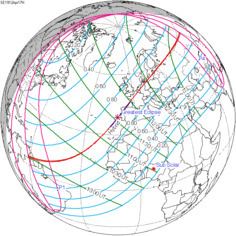Nature Hybrid Magnitude 1.0003 Max. width of band 1 km (0.62 mi) Start date April 17, 1912 | Gamma 0.528 Duration 2 sec (0 m 2 s) Greatest eclipse 11:34:22 | |
 | ||
A total solar eclipse occurred on April 17, 1912. It is a hybrid event, starting and ending as an annular eclipse, with only a small portion of totality. A solar eclipse occurs when the Moon passes between Earth and the Sun, thereby totally or partly obscuring the image of the Sun for a viewer on Earth. A total solar eclipse occurs when the Moon's apparent diameter is larger than the Sun's, blocking all direct sunlight, turning day into darkness. Totality occurs in a narrow path across Earth's surface, with the partial solar eclipse visible over a surrounding region thousands of kilometres wide. Totality was visible over the sea between Spain and France, with annularity continued northeast across Europe and Asia.
This eclipse occurred two days after the RMS Titanic sank in the northwestern Atlantic ocean under the darkness of new moon.
Solar eclipses 1910-1913
Each member in a semester series of solar eclipses repeats approximately every 177 days and 4 hours (a semester) at alternating nodes of the Moon's orbit.
